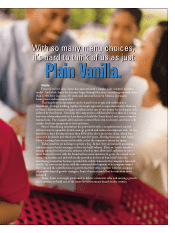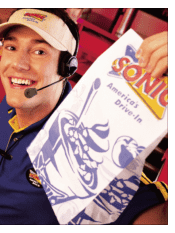Sonic 2002 Annual Report Download - page 19
Download and view the complete annual report
Please find page 19 of the 2002 Sonic annual report below. You can navigate through the pages in the report by either clicking on the pages listed below, or by using the keyword search tool below to find specific information within the annual report.
Sonic 02 17
Management’s Discussion and Analysis
with lower unit costs for potatoes and pork to more than offset higher beef, dairy and packaging costs. Payroll and
employee benefits, as a percentage of company-owned restaurant sales, increased 50 basis points from fiscal year 2000 as
a result of several factors including an increase in the average wage rate, additional labor related to the company’s effort
to expand its business in under-penetrated day parts, including an expanded breakfast program, as well as incremental
training hours associated with an ongoing Quality Assurance initiative. Other operating expenses decreased 10 basis
points due to the leveraging of fixed costs over higher volumes and a lower rate of discounting. Minority interest in
earnings of restaurants increased 22.3% to $12.4 million in fiscal year 2001, compared to $10.2 million in fiscal year 2000.
Selling, general and administrative expenses, as a percentage of total revenues, decreased to 9.3% in fiscal year 2001,
compared with 10.0% in fiscal year 2000. Depreciation and amortization expense increased 17.6% to $23.9 million in
fiscal year 2001 resulting primarily from store acquisitions and new drive-in development as well as store equipment and
technology upgrades.
During fiscal year 2001, two drive-ins became impaired under the guidelines of FAS 121, “Accounting for the
Impairment of Long-Lived Assets.” As a result, a provision for impairment of $0.8 million was recorded for the drive-
ins’ carrying cost in excess of the present value of estimated future cash flows. Two drive-ins also became impaired under
the guidelines of FAS 121 in fiscal year 2000, resulting in an impairment of $1.0 million.
Income from operations increased 18.2% to $67.6 million in fiscal year 2001 from $57.2 million in fiscal year 2000.
Net interest expense in fiscal year 2001 increased 6.5% to $5.5 million from $5.2 million in fiscal year 2000. This
increase was the result of additional borrowings to fund share repurchases of $2.1 million and capital expenditures of
$90.1 million including $29.1 million for acquisitions.
Provision for income taxes reflects an effective federal and state tax rate of 37.25% for fiscal year 2001 and 2000.
Net income increased 19.4% to $39.0 million in fiscal year 2001 compared to $32.6 million in fiscal year 2000. Diluted
earnings per share increased to $0.93 per share in fiscal year 2001, compared to $0.78 per share in fiscal year 2000, for an
increase of 19.7%.
Liquidity and Sources of Capital
Net cash provided by operating activities increased $17.8 million or 27.1% in fiscal year 2002 as compared to the
same period in fiscal year 2001, primarily as the result of the increase in operating profit before depreciation and
amortization and the provision for deferred income taxes.
The company opened 40 newly-constructed restaurants and acquired a net of 20 existing restaurants from
franchisees in fiscal year 2002. The company funded total capital additions for fiscal year 2002 of $71.1 million, which
included the cost of newly-opened restaurants, new equipment for existing restaurants, retrofits of existing restaurants,
restaurants under construction, acquired restaurants, and other capital expenditures, from cash generated by operating
activities and through borrowings under the company’s line of credit. During fiscal year 2002, the company purchased
the real estate for 46 of the 65 newly-constructed and acquired restaurants. The company expects to own the land and
building for most of its future newly-constructed restaurants.
The company’s board of directors expanded the stock repurchase program during fiscal year 2002, increasing the
funds authorized for the repurchase of the company’s common stock from $74.6 million to $130.3 million and extended
the term of the program to December 31, 2003. The company repurchased approximately 1.2 million shares of common
stock at an aggregate cost of $26.0 million during the year, leaving approximately $49.3 million available under the share
repurchase program as of the end of the fiscal year. As of August 31, 2002, the company’s total cash balance of $9.0
million reflected the impact of the cash generated from operating activities, borrowing activity, and capital expenditures
mentioned above.
The company has an agreement with a group of banks which provides the company with an $80.0 million line of
credit expiring in July of 2004. The company plans to use the line of credit to finance the opening of newly-constructed
restaurants, acquisitions of existing restaurants, purchases of the company’s common stock, retirement of senior notes and
for other general corporate purposes. As of August 31, 2002, the company’s outstanding borrowings under the line of
credit were $29.0 million, at an effective borrowing rate of 3.9%, as well as $0.2 million in outstanding letters of credit.
The amount available under the line of credit as of August 31, 2002, was $50.8 million. See Note 9 of the Notes to
Consolidated Financial Statements for additional information regarding the company’s long-term debt.
























